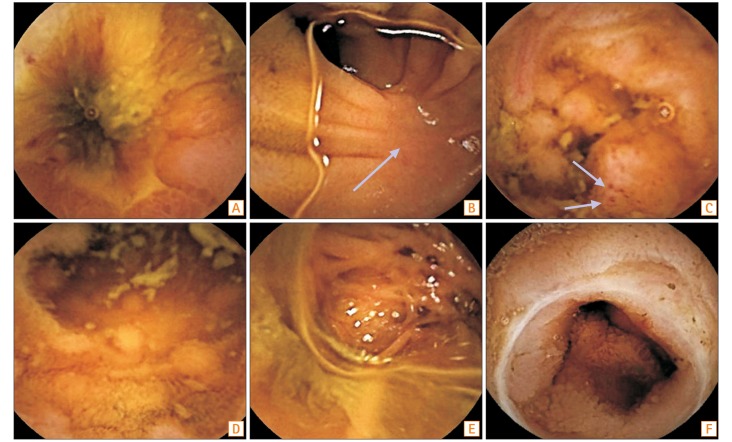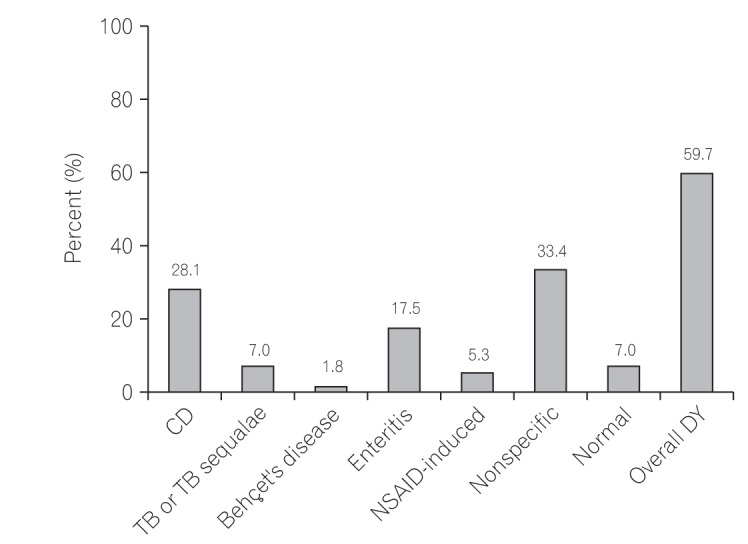Intest Res.
2017 Oct;15(4):467-474. 10.5217/ir.2017.15.4.467.
Practice patterns and clinical significance of use of capsule endoscopy in suspected and established Crohn's disease
- Affiliations
-
- 1Institute for Digestive Research, Digestive Disease Center, Soonchunhyang University College of Medicine, Seoul, Korea. 94jsr@hanmail.net, jokim@schmc.ac.kr
- KMID: 2396396
- DOI: http://doi.org/10.5217/ir.2017.15.4.467
Abstract
- BACKGROUND/AIMS
Although the role of capsule endoscopy (CE) in Crohn's disease (CD) has expanded, CE is not used routinely for diagnosing and evaluating CD in Korea. We aimed to investigate current patterns of practice and evaluate the clinical significance of the use of CE in CD in Korean patients.
METHODS
Among 651 CE procedures performed for various indications, we retrospectively analyzed the medical records of patients who underwent CE in 57 cases of suspected CD (sCD) and 14 cases of established CD (eCD).
RESULTS
In the sCD group, CE was most commonly used for the initial diagnosis of CD (54.4%). Capsule retention was found in only 1 patient in the eCD group (1/71, 1.4%). In the sCD group, 28.1% of patients were diagnosed with CD on the basis of CE findings; other diseases diagnosed included tuberculous enteritis (7.0%), non-steroidal anti-inflammatory drug-induced enteropathy (5.3%), and other enteritis (17.5%). Only 11.5% of patients with eCD (14/122) underwent CE. The indication for CE in the 14 patients with eCD was to assess disease extent and activity. The overall diagnostic yield of CE was 59.7%. Therapeutic strategies were changed in 70.2% of patients in the sCD group and 50% of those in the eCD group based on CE findings.
CONCLUSIONS
In clinical practice, CE was most commonly indicated for the initial diagnosis of CD and was not generally performed in patients with eCD. CE appears to be an effective diagnostic modality for evaluating sCD and is useful for determining therapeutic strategies for patients with sCD and those with eCD.
Keyword
MeSH Terms
Figure
Cited by 1 articles
-
Role of capsule endoscopy in suspected or established Crohn's disease in real practice
Hyun Joo Jang
Intest Res. 2017;15(4):431-433. doi: 10.5217/ir.2017.15.4.431.
Reference
-
1. Kornbluth A, Colombel JF, Leighton JA, Loftus E; ICCE. ICCE consensus for inflammatory bowel disease. Endoscopy. 2005; 37:1051–1054. PMID: 16189789.
Article2. Louis E, Collard A, Oger AF, Degroote E, Aboul Nasr El Yafi FA, Belaiche J. Behaviour of Crohn's disease according to the Vienna classification: changing pattern over the course of the disease. Gut. 2001; 49:777–782. PMID: 11709511.
Article3. Cosnes J, Gower-Rousseau C, Seksik P, Cortot A. Epidemiology and natural history of inflammatory bowel diseases. Gastroenterology. 2011; 140:1785–1794. PMID: 21530745.
Article4. ASGE Technology Committee. Wang A, Banerjee S, et al. Wireless capsule endoscopy. Gastrointest Endosc. 2013; 78:805–815. PMID: 24119509.
Article5. Yang SK, Yun S, Kim JH, et al. Epidemiology of inflammatory bowel disease in the Songpa-Kangdong district, Seoul, Korea, 1986-2005: a KASID study. Inflamm Bowel Dis. 2008; 14:542–549. PMID: 17941073.
Article6. Carter D, Eliakim R. Current role of endoscopy in inflammatory bowel disease diagnosis and management. Curr Opin Gastroenterol. 2014; 30:370–377. PMID: 24837226.
Article7. Kopylov U, Nemeth A, Koulaouzidis A, et al. Small bowel capsule endoscopy in the management of established Crohn's disease: clinical impact, safety, and correlation with inflammatory biomarkers. Inflamm Bowel Dis. 2015; 21:93–100. PMID: 25517597.
Article8. Lazarev M, Huang C, Bitton A, et al. Relationship between proximal Crohn's disease location and disease behavior and surgery: a cross-sectional study of the IBD Genetics Consortium. Am J Gastroenterol. 2013; 108:106–112. PMID: 23229423.
Article9. Kim M, Jang HJ. The role of small bowel endoscopy in small bowel Crohn's disease: when and how? Intest Res. 2016; 14:211–217. PMID: 27433142.
Article10. Kopylov U, Yablecovitch D, Lahat A, et al. Detection of small bowel mucosal healing and deep remission in patients with known small bowel Crohn's disease using biomarkers, capsule endoscopy, and imaging. Am J Gastroenterol. 2015; 110:1316–1323. PMID: 26215531.
Article11. Marmo R, Rotondano G, Piscopo R, et al. Capsule endoscopy versus enteroclysis in the detection of small-bowel involvement in Crohn's disease: a prospective trial. Clin Gastroenterol Hepatol. 2005; 3:772–776. PMID: 16234005.
Article12. Triester SL, Leighton JA, Leontiadis GI, et al. A meta-analysis of the yield of capsule endoscopy compared to other diagnostic modalities in patients with non-stricturing small bowel Crohn's disease. Am J Gastroenterol. 2006; 101:954–964. PMID: 16696781.
Article13. Solem CA, Loftus EV Jr, Fletcher JG, et al. Small-bowel imaging in Crohn's disease: a prospective, blinded, 4-way comparison trial. Gastrointest Endosc. 2008; 68:255–266. PMID: 18513722.
Article14. Esaki M, Matsumoto T, Watanabe K, et al. Use of capsule endoscopy in patients with Crohn's disease in Japan: a multicenter survey. J Gastroenterol Hepatol. 2014; 29:96–101. PMID: 24354993.
Article15. Dionisio PM, Gurudu SR, Leighton JA, et al. Capsule endoscopy has a significantly higher diagnostic yield in patients with suspected and established small-bowel Crohn's disease: a meta-analysis. Am J Gastroenterol. 2010; 105:1240–1248. PMID: 20029412.
Article16. Van Assche G, Dignass A, Panes J, et al. The second European evidence-based consensus on the diagnosis and management of Crohn's disease: definitions and diagnosis. J Crohns Colitis. 2010; 4:7–27. PMID: 21122488.
Article17. Yao T, Matsui T, Hiwatashi N. Crohn's disease in Japan: diagnostic criteria and epidemiology. Dis Colon Rectum. 2000; 43(10 Suppl):S85–S93. PMID: 11052483.18. Gay GJ, Delmotte JS. Enteroscopy in small intestinal inflammatory diseases. Gastrointest Endosc Clin N Am. 1999; 9:115–123. PMID: 9834320.
Article19. Mehdizadeh S, Chen GC, Barkodar L, et al. Capsule endoscopy in patients with Crohn's disease: diagnostic yield and safety. Gastrointest Endosc. 2010; 71:121–127. PMID: 19863957.
Article20. Lee YJ, Yang SK, Byeon JS, et al. Analysis of colonoscopic findings in the differential diagnosis between intestinal tuberculosis and Crohn's disease. Endoscopy. 2006; 38:592–597. PMID: 16673312.
Article21. Gay G, Delvaux M, Frederic M. Capsule endoscopy in non-steroidal anti-inflammatory drugs-enteropathy and miscellaneous, rare intestinal diseases. World J Gastroenterol. 2008; 14:5237–5244. PMID: 18785273.
Article22. Pons Beltrán V, González Suárez B, González Asanza C, et al. Evaluation of different bowel preparations for small bowel capsule endoscopy: a prospective, randomized, controlled study. Dig Dis Sci. 2011; 56:2900–2905. PMID: 21479818.
Article23. Rameshshanker R, Arebi N. Endoscopy in inflammatory bowel disease when and why. World J Gastrointest Endosc. 2012; 4:201–211. PMID: 22720120.
Article24. Ng WK, Wong SH, Ng SC. Changing epidemiological trends of inflammatory bowel disease in Asia. Intest Res. 2016; 14:111–119. PMID: 27175111.
Article25. Luján-Sanchis M, Sanchis-Artero L, Suárez-Callol P, Medina-Chuliá E. Indications of capsule endoscopy in Crohn's disease. Rev Esp Enferm Dig. 2014; 106:37–44. PMID: 24689714.
Article26. Hudesman D, Mazurek J, Swaminath A. Capsule endoscopy in Crohn's disease: are we seeing any better? World J Gastroenterol. 2014; 20:13044–13051. PMID: 25278698.
Article27. Eliakim R, Suissa A, Yassin K, Katz D, Fischer D. Wireless capsule video endoscopy compared to barium follow-through and computerised tomography in patients with suspected Crohn's disease: final report. Dig Liver Dis. 2004; 36:519–522. PMID: 15334771.
Article28. Chong AK, Taylor A, Miller A, Hennessy O, Connell W, Desmond P. Capsule endoscopy vs. push enteroscopy and enteroclysis in suspected small-bowel Crohn's disease. Gastrointest Endosc. 2005; 61:255–261. PMID: 15729235.
Article29. Efthymiou A, Viazis N, Vlachogiannakos J, et al. Wireless capsule endoscopy versus enteroclysis in the diagnosis of small-bowel Crohn's disease. Eur J Gastroenterol Hepatol. 2009; 21:866–871. PMID: 19417679.
Article30. Liao Z, Gao R, Xu C, Li ZS. Indications and detection, completion, and retention rates of small-bowel capsule endoscopy: a systematic review. Gastrointest Endosc. 2010; 71:280–286. PMID: 20152309.31. Hall B, Holleran G, Chin JL, et al. A prospective 52 week mucosal healing assessment of small bowel Crohn's disease as detected by capsule endoscopy. J Crohns Colitis. 2014; 8:1601–1609. PMID: 25257546.
Article32. Pons Beltrán V, Nos P, Bastida G, et al. Evaluation of postsurgical recurrence in Crohn's disease: a new indication for capsule endoscopy? Gastrointest Endosc. 2007; 66:533–540. PMID: 17725942.
Article
- Full Text Links
- Actions
-
Cited
- CITED
-
- Close
- Share
- Similar articles
-
- Role of capsule endoscopy in suspected or established Crohn's disease in real practice
- The Role of Capsule Endoscopy in the Diagnosis of Crohn's Disease
- Balloon-Assisted Enteroscopy and Capsule Endoscopy in Suspected Small Bowel Crohn's Disease
- Capsule Endoscopy in Children
- Retrieval of a Retained Capsule due to Isolated Crohn's Enteritis by Means of Double Balloon Enteroscopy



